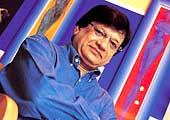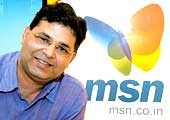|
Earlier
this month, Pepsi India did something that no advertiser would
have dared to do before. It launched a TV commercial on the internet.
The three-part 'webisode', featuring Pepsi's brand ambassador
and Bollywood superstar Shahrukh Khan as a flirtatious snake charmer,
ran on Yahoo! India for an entire week and was a teaser for the
TV spot that debuted later. This was the first time in India that
an internet commercial was produced simultaneously with the TV
commercial. "It shows the increasing importance youth marketers
like Pepsi are attributing to the digital media," says Pearl
Uppal, Sales Director, Yahoo! India.
Pepsi's innovative strategy of premiering
a TV spot on the net is a pointer to how the Indian internet business
has come of age. Ten years after the beginning of the commercial
internet era, advertisers are finally taking notice of it. There
are numbers to prove that: last year, media portals like Yahoo!,
Rediff, Indiatimes, msn India and Sify had a combined advertising
revenue of Rs 105 crore and are expecting to grow that by 50 per
cent this year. Says Sanjeev Bikhchandani, CEO of India's largest
jobsite Naukri.com, which is also one of the biggest advertisers
on the net with some Rs 10 crore budgeted for online ad-spend
this year: "There is a clear revival of internet advertising
in India. We ourselves have doubled our online ad budget."
 |
| Rediff's Balakrishnan: Well, he sure
has reason to smile |
The Boom Is Here
For others, like Rediff.com, India's oldest
(founded in 1995) internetmedia major, the increased online ad
spend has meant a turnaround in fortunes. Riding on the boom,
Rediff has been able to cut its net loss for the year ended March
31, 2005 to $1.4 million (Rs 6.16 crore) from $5.7 million (Rs
25.08 crore) in the previous year. In the first quarter of this
year, Rediff's India revenues grew 114 per cent.
Says Rediff.com's Chairman and CEO Ajit Balakrishnan:
"The beginning of the revival (of online advertising) actually
started 24 months ago. But in the last 12 months, it has been
great going." Now Balakrishnan has reached a stage where
his advertisers have to wait for buying space on his portal. "We
have all our inventories sold out," he smiles. Ditto at Rediff's
rival Yahoo! India. "Ad inventory is in short supply. From
October onwards, we are increasing our rates," says Neville
Taraporevalla, Country General Manager, Yahoo! India. Portals
like msn India and Indiatimes, too, claim that they have seen
a 100 per cent year-on-year growth in ad revenues in the last
two years.
What is interesting is, along with the boom,
ad rates have also gone up. The rates for premium positions charged
by Rediff and Yahoo! are as expensive as front page ads of a national
daily. Rediff's Balakrishnan says he would charge anywhere between
Rs 5-7 lakh a day for a display ad on the home page. Yahoo! raked
in a whopping $25,000 (Rs 11 lakh) for two days for the Oye Bubbly
campaign it did for cola major Pepsi. Says Taraporewalla: "We
don't take ads for less than $3,000 (Rs 1,25,000). That's our
minimum ticket size."
| INTERNET ADVERTISING IN THE US |
| Indian online
advertising market (Rs 105 crore in 2004-05 and an estimated
Rs 155 crore for 05-06) is less than chump change compared
to that of the US market, which had $9.6 billion (Rs 43,200
crore) in 2004 and is expected to clock $12.9 billion (Rs
56,760 crore) in 2005. Portal giant Yahoo had more than $1
billion (Rs 4,400 crore) in online ad revenue in the first
quarter of 2005, which rose to $1.25 billion (Rs 5,500 crore)
for the second quarter. Google's second quarter ad revenues
were slightly higher at $1.36 billion (Rs 5,984 crore). A
few months back, Advertising Age predicted that the combined
advertising revenues of Google and Yahoo this year would rival
the combined prime time ad revenues of America's three big
television networks, ABC, CBC and NBC. Clearly, the US online
ad market is a different kettle of fish. According to a latest
report by research agency eMarketer, internet ad-spend in
the US is projected to reach $22.3 billion (Rs 98,120 crore)
in 2009, indicating that internet is becoming truly a mainstream
medium there. The US online admarket is also much bigger than
the other developed markets like the UK ($645 million or Rs
2,838 crore), Australia ($488 million or Rs 2,147.2 crore)
and Canada ($519 million or Rs 2,283.6 crore). According to
ZenithOptimedia, the worldwide online ad market is expected
to grow at 21 per cent year-on-year for the next few years.
|
Growth Drivers
So, the internet in India has finally made
its cut as a serious advertising vehicle. What has been driving
the growth? First the broad numbers. India currently has 40 million
internet users according to estimates available with this magazine
(Software lobby Nasscom's projection for 2005 is 52 million).
Companies like Yahoo! and Rediff, however, believe the number
is smaller, around 25 million. Either way, that's up from a mere
one million in 2000. This is expected to grow at 20-30 per cent
year-on-year. But more than numbers, it is the category of users
that online media companies serve up to advertisers that matters.
The internet has penetrated over 30 per cent of India's English-speaking
urban audience. About 60-70 per cent of the brand decisions on
consumer categories like cars and houses are taken by people in
the age group 20-35, where internet has penetrated more than 50
per cent. Says Rediff's Balakrishnan: "Most of them don't
read newspapers or watch TV." So portals are pegging internet
as a medium to reach this influential class of consumers.
An interesting twist to the story is that
some of the ad-spend going to traditional media will now be diverted
to the internet. India's total advertising market (print plus
TV) is about Rs 10,000 crore. Print has a readership of 40-50
million, and accounts for Rs 4,500 crore or 45 per cent of this
market. But print readership as well as print advertising is stagnating.
So with internet grabbing more users, there is likely to be a
shift in advertising-although marginal-from print to online.
 |
 |
| Times Internet CEO Mahendra Swaroop: Boom time |
Yahoo! India's Taraporevalla: Plans to hike rates |
According to Balakrishnan, the inflection
point for this shift will happen when India's internet user base
reaches 40 million-comparable to the print reader base. By some
estimates the growth in online advertising we are seeing right
now is because that point of inflection has been reached. According
to Balakrishnan, India is expected to have such a net base in
two or three years.
Currently, the ad revenue per internet subscriber
in India is $1 (Rs 44) as against $4-5 (Rs 180-220) in the developed
markets. "As the net user base expands, we expect the per
user monetisation to reach at least $2 (Rs 88) in India,"
says Rajneesh, Head (Marketing), msn India.
So who are the advertisers? Currently, internet
job portals (like Naukri and Monster), matrimony portals (Shaadi,
BharatMatrimony and Jeevansathi) and travel portals (makemytrip.com)
account for about 25 per cent of the total online ad-spend, followed
by financial services companies and banks like Citibank, HDFC,
ICICI Bank and Tata AIG accounting for 22 per cent (see Eyeing
Eyeballs). Says Vijay Ramachandran, Marketing Director, e-business,
Citibank, "Online advertising is a significant component
of our advertising plan, accounting for over 10 per cent of our
total media spend." Ramachandran adds that the company will
increase its online spend by 20 per cent year-on-year.
 |
 |
| Mediaturf's Ramani: The internet can
no longer be ignored |
MSN's Rajneesh: Forsees surge in ad
revenues |
But, says Yahoo's Uppal, the next stage of
growth will come in from traditional advertisers in categories
like FMCG (HLL, Pepsi, Coke), telecom (Airtel, Tata Indicom, Reliance)
and automobiles (Maruti, Tata Motors and Hyundai) whose share
in online ad-spend could go up to 40-50 per cent from the current
30-odd per cent. Says Vipul Prakash, Executive Vice President
(Marketing), Pepsi Foods: "I expect marketers, at least in
our industry, to allocate 10 per cent of their total ad budget
to online in the long term."
If Prakash's prediction is true, that's big
money. For instance, Hindustan Lever alone has an ad budget of
Rs 700 crore a year. In fact, the trend has already started. Lever
has created a separate online ad budget (for its products like
Axe deodorant and Close Up toothpaste, both targeted at the young
consumer). Says Rohit Sharma, Head, Sales and Marketing, Times
Internet Ltd, which runs seven online portals like Indiatimes
and TimesofIndia.com, "They (Lever) have bought media from
us for the whole year."
Besides, other traditional advertisers like
Maruti and Tata Motors are increasingly looking at the net for
customer acquisition and have started spending more. Says V. Ramani,
CEO, Mediaturf, the leading online media agency: "The willingness
of marketers to view the internet like other media forms is the
key behind the recent trend." And with the net garnering
increasing numbers of users, there will be no other way for marketers
to view it.
|









